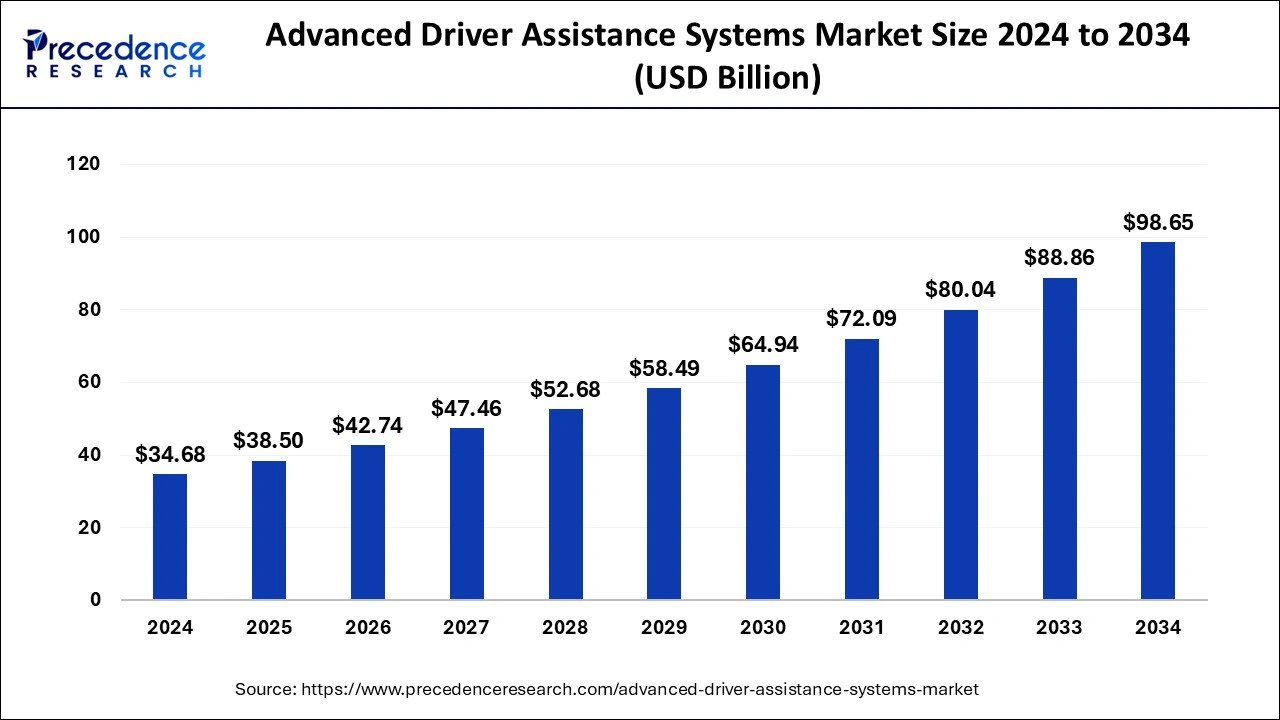The Advanced Driver Assistance Systems (ADAS) market is set to skyrocket, growing by USD 98.65 billion by 2034 from USD 98.65 billion in 2022, with an impressive CAGR of 11.02% driving transformative growth.
Critical Observations
- In 2024, the LiDAR sensors segment held a significant share of the market by component type.
- The software segment is projected to grow at an impressive CAGR from 2025 to 2034.
- The commercial car segment is witnessing robust growth, expanding at a CAGR of 17.3% by vehicle type.
- The tire pressure monitoring system segment captured over 20.7% of the market share in 2024 by solution type.
- The autonomous emergency braking segment is expected to achieve a remarkable CAGR of 21.5% during the forecast period.

Advanced Driver Assistance Systems, in general, represent a collection of active and passive technologies to increase safety for the driver, passenger, and pedestrians. Such systems depend on important components like cameras, sensors, radar, and advanced software for optimal performance. With autonomous vehicles becoming more prominent, ADAS is on an upward trajectory with the primary objective of improved safety, comfort, and efficiency. The companies in the industry are investing a lot in research and development to improve the rising demand for high–class safety features as well as a better driving experience.
Sample link: https://www.precedenceresearch.com/sample/1007
Market Landscape
| Report Coverage | Details |
| Market Size by 2025 | USD 38.50 Billion |
| Market Size in 2034 | USD 98.65 Billion |
| Growth Rate | CAGR of 11.02% from 2025 to 2034 |
| Largest Market | North America |
| Base Year | 2024 |
| Forecast Period | 2025 to 2034 |
| Segments Covered | System Type, Vehicle Type, Sensor Type, Electric Vehicle, Level of Autonomy, Region |
Core Factors
The demand for safer roads and advanced vehicle security features that avoid accidents and save lives drives the ADAS market. Government regulations on strict safety measures are forcing manufacturers to install ADAS technologies, and the advent of autonomous vehicles is pushing their acceptance to enhance automation and efficiency in driving. Increasingly, consumers are demanding adaptive cruise control and parking assistance to make driving comfortable. Advanced sensor and camera technologies along with better connectivity make ADAS more affordable. Moreover, increasing awareness about road safety and importance of driver assistance systems further increases demand within the market.
Potentials
- Rise of Autonomous Vehicles: The growing demand for self-driving cars is unlocking immense potential for incorporating advanced ADAS technologies to enhance automation and safety.
- Breakthrough Innovations: Cutting-edge advancements in AI, machine learning, and sensor technologies are revolutionizing ADAS, making vehicles smarter, safer, and more efficient.
- Booming EV Market: The rapid adoption of electric vehicles (EVs) is driving the need for ADAS to enable sophisticated features in these environmentally friendly cars.
- Government Support: Favorable regulations and incentives for safer, smarter transportation are accelerating the adoption of ADAS on a global scale.
- Aftermarket Opportunities: Retrofitting ADAS in older vehicles opens up new possibilities to serve a wider audience beyond just new car buyers.
- Strategic OEM Collaborations: Partnering with original equipment manufacturers (OEMs) allows ADAS providers to seamlessly integrate their systems into diverse vehicle models, broadening their market footprint.
Obstacles
- High Development Costs: The advanced technologies behind ADAS, including sensors, cameras, and software, come with high development costs, making implementation a financial challenge for car manufacturers.
- Integration Challenges: Integrating ADAS into existing vehicle platforms is a complex task that requires careful calibration, which increases production costs and can lead to delays.
- Privacy and Security Concerns: The extensive data collected by ADAS systems raises significant concerns about cybersecurity and the protection of sensitive information.
- Regulatory Barriers: The constantly evolving regulatory frameworks and standards across different regions pose significant obstacles to the widespread adoption of ADAS technologies.
- Consumer Cautiousness: Some drivers may be hesitant to fully trust or adopt the autonomous features of ADAS, limiting its demand in certain markets.
- Sensor Limitations: ADAS sensors can face limitations caused by environmental factors such as adverse weather, poor lighting, or road obstructions, which may impair their effectiveness.
Regional Insights
Market Key Players
- Robert Bosch GmbH
- Continental AG
- Magna International
- Veoneer
- Hyundai Mobis
- ZF Friedrichshafen
- Valeo
- NVIDIA
- Intel
Recent News
Market Segmentation
By System Type
- Intelligent Park Assist (IPA)
- Lane Departure Warning (LDW)
- Road Sign Recognition (RSR)
- Tire Pressure Monitoring System (TPMS)
- Night Vision System (NVS)
- Automatic Emergency Braking (AEB)
- Adaptive Cruise Control (ACC)
- Adaptive Front Light (AFL)
- Blind Spot Detection (BSD)
- Cross Traffic Alert (CTA)
- Driver Monitoring System (DMS)
- Forward Collision Warning (FCW)
- Others
By Sensor Type
- Image Sensors
- Ultrasonic Sensors
- LiDAR
- Radar Sensors
- Infrared (IR) Sensors
- Laser Sensors
By Vehicle Type
- Passenger Car
- Light Commercial Vehicle
- Truck
- Bus
By Level of Autonomy
- L1
- L2
- L3
- L4
- L5
By Electric Vehicle
- Battery Electric Vehicles (BEV)
- Hybrid Electric Vehicles (HEV)
- Plug-in Hybrid Electric Vehicle (PHEV)
- Fuel Cell Electric Vehicle (FCEV)
Ready for more? Dive into the full experience on our website!
Website: https://www.precedenceresearch.com/
